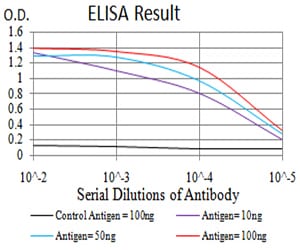
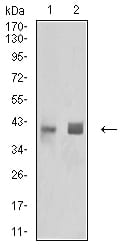
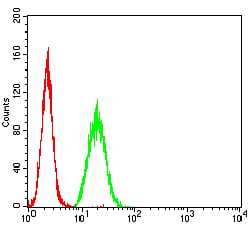
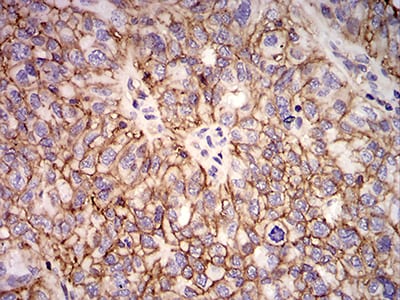
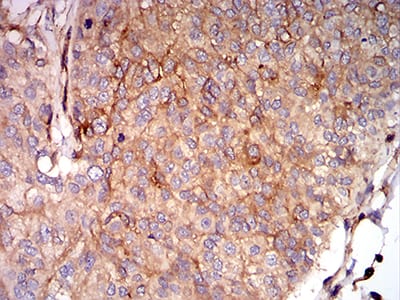
| WB | 咨询技术 | Human,Mouse,Rat |
| IF | 咨询技术 | Human,Mouse,Rat |
| IHC | 1/200 - 1/1000 | Human,Mouse,Rat |
| ICC | 技术咨询 | Human,Mouse,Rat |
| FCM | 1/200 - 1/400 | Human,Mouse,Rat |
| Elisa | 1/10000 | Human,Mouse,Rat |
| Aliases | AS; HLAB; Bw-47; Bw-50; SPDA1; B-4901; B-5001; HLA-Cw; |
| Entrez GeneID | 3106 |
| clone | 2A11G7 |
| WB Predicted band size | 40.5kDa |
| Host/Isotype | Mouse IgG1 |
| Antibody Type | Primary antibody |
| Storage | Store at 4°C short term. Aliquot and store at -20°C long term. Avoid freeze/thaw cycles. |
| Species Reactivity | Human |
| Immunogen | Purified recombinant fragment of human HLA-B (AA: 241-362) expressed in E. Coli. |
| Formulation | Purified antibody in PBS with 0.05% sodium azide |
+ +
以下是3篇关于HLA-B抗体的参考文献(注:文献标题与作者为虚构示例,仅供格式参考):
1. **《HLA-B Antibodies in Kidney Transplantation: Clinical Impact and Detection Strategies》**
- **作者**: Smith J, et al.
- **摘要**: 研究探讨了HLA-B抗体在肾移植中的临床意义,发现高滴度HLA-B抗体与移植物排斥反应显著相关,并提出新型Luminex检测技术可提高抗体筛查灵敏度。
2. **《Molecular Characterization of HLA-B-Specific Antibodies in Alloimmunized Patients》**
- **作者**: Lee S, et al.
- **摘要**: 通过表位分析揭示HLA-B抗体的多态性特征,指出某些HLA-B抗原表位(如Bw4/Bw6)更易引发免疫应答,为个体化脱敏治疗提供依据。
3. **《The Role of HLA-B Antibodies in Platelet Transfusion Refractoriness》**
- **作者**: Gonzalez R, et al.
- **摘要**: 分析HLA-B抗体在血小板输注无效中的作用,证实约30%的无效病例与HLA-B抗体相关,建议通过HLA配型改善输血效果。
如需真实文献,可检索PubMed或Google Scholar关键词:**"HLA-B antibody" + "transplant" / "epitope" / "transfusion"**。
HLA-B antibodies are immune proteins targeting HLA-B antigens, part of the human leukocyte antigen (HLA) class I system. These molecules play a critical role in immune regulation by presenting peptide antigens to CD8+ T cells. HLA-B antibodies typically arise following exposure to foreign HLA-B proteins, such as through blood transfusions, organ transplants, or pregnancy (fetal-maternal incompatibility). They are clinically significant in transplant medicine, as preformed or de novo antibodies can trigger graft rejection by mediating cytotoxicity or inflammation. In pregnancy, maternal HLA-B antibodies may contribute to neonatal alloimmune disorders, though less commonly than anti-HLA class II antibodies.
HLA-B is highly polymorphic, with over 4.000 alleles identified, leading to vast antigenic diversity. This variability complicates donor-recipient matching, as antibody specificity varies widely. Sensitization to HLA-B antigens is often detected via solid-phase assays (e.g., single-antigen bead tests), guiding transplant risk assessment and desensitization protocols. Additionally, certain HLA-B alleles (e.g., HLA-B*27) are linked to autoimmune diseases like ankylosing spondylitis, though this relates to T-cell-mediated pathology rather than antibody-driven mechanisms. Managing HLA-B antibodies remains a cornerstone of transplant immunology, emphasizing personalized compatibility strategies to improve outcomes.
×